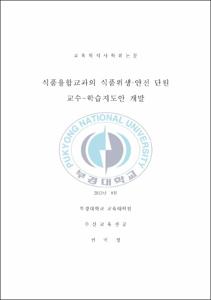식품융합교과의 식품위생·안전 단원 교수-학습지도안 개발
- Alternative Title
- Development of Lesson Plans for Food Hygiene and Safety in Food Convergence
- Abstract
- 삶의 질과 건강을 추구하는 웰빙(Well-being) 문화는 2000년대 이후 우리나라 사회와 산업에 큰 영향을 미쳤으며 식품산업과 매우 밀접하게 관련되어 있다.
식품산업 시장이 커짐에 따라 저급 중국산 수입식품에 대한 불안, 다양한 식품첨가물에 대한 안전성 위협, 식품 이물에 대한 위험성 증대, 식품 산업화에 의한 화학물질 사용량의 급증에 따른 피해 증대, 부정, 불량식품, 식중독 발생 등의 식품 위생·안전 관련 사고는 식품 산업에 부정적 시각이 가중됨에 따라 식품 위생·안전 전문 교육이 필요하다.
본 연구는 식품계 특성화 고등학교 3학년 학생을 대상으로 미래 식품업계 예비 종사자로서 식품 위생·안전에 관한 기본 지식위에 실천할 수 있는 태도와 능력 형성을 위한 식품융합교과의 식품위생·안전 교육의 기초 자료로 교수-학습 지도안을 개발하고자 한다.
2장에서는 선행연구를 통해 식품산업에서 식품 위생·안전사고의 실태와 특징을 분석하고, 우리나라 식품위생·안전 교육의 문제점을 제시한다. 3장에서는 연구의 방법과 분석방법 등 교수-학습 지도안의 개발과정을 다룬다. 4장에서는 식품 위생·안전 관련사고와 7권의 교과서 분석을 토대로 식품위생, 개인·환경위생, 식중독, 식품안전 등의 4가지 영역으로 나누어 각 5차시씩 총 20차시의 식품 위생·안전 교육 내용을 선정하고, 식품 위생·안전 교육의 교수-학습 지도안을 개발한다.
교수-학습 지도안은 STEAM 융합교육으로 수업과정에서 학생들의 자발적 참여와 비판적인 사고를 이끌어 내어 학생들의 문제해결능력을 기르는데 주안점을 둔다. 기본적인 지식을 바탕으로 식품과 산업, 인간에 대해 폭넓은 사고와 실천을 가능케 하고자 새로운 교육과정 개발 필요성에 따라 ‘식품융합’ 교과를 통해 지식을 응용, 심화하여 건전한 태도와 실천을 가능케 할 수 있도록 구성한다.
The culture of Well-being proclaiming the quality and health in lifestyle has had an enormous social and industrial impact since the beginning of this millennium, especially in the food industry which is inexorably tied to it.
With the ever-growing food market accountability and ensuing food relevant issues such as national anxiety over unconditional distribution of imported inferior quality food ingredients especially from China, threats over the various chemical additives in food, food contaminations and pathological concerns as well as the risk of adulterated food intake, food hygiene and safety education has become a necessary subject to adopt in school education.
The research hereby is aimed at the development of the proper lesson plan models which serve as the foundational resources from which the senior students of specialized high schools can be equipped with the appropriate mind and attitudes before they delve into the world of food industry professionals.
In chapter 2, based on the preliminary research and analysis on the current social phenomena of food hygiene and safety incidents that we encounter in reality, we recommend the relevant issues to overcome in Food Hygiene and Safety Education.
In chapter 3, we will discuss the procedures involved in the development of the lesson plans including the various research and analysis approaches, which lead into practical lesson plans based on the 4 sub-categorized subjects analyzed throughout 7 different text books of food hygiene and safety education as followings: Food Hygiene, Personal and Environmental Hygiene, Food Contamination Incidents, Food Poisoning, and Food Safety.
Lesson Plans represents STEAM associated education involving the partnerships between business-associated teachers and food educational teachers, focusing on cultivating the students' problem-solving abilities by inducing voluntary participation and critical thinking.
In response to the urgent needs of new curriculums, this lesson plan is devised to promote learners' more profound understanding about the food industry and how human life revolves around it and further advanced applications through learning Food Convergence subject.
- Issued Date
- 2013
- Awarded Date
- 2013. 8
- Type
- Dissertation
- Publisher
- 부경대학교
- Alternative Author(s)
- Kwon, Mi Jung
- Affiliation
- 교육대학원
- Department
- 교육대학원 수산교육전공
- Advisor
- 박종운
- Table Of Contents
- 목 차
Abstract(in English) ⅵ
Ⅰ. 서론 1
1. 연구의 필요성 1
2. 연구의 방법과 범위 4
가. 연구의 방법 4
나. 연구의 범위 6
Ⅱ. 이론적 배경 8
1. 식품위생·안전교육의 시스템과 사회적 요구 8
가. 식품 위생·안전 교육의 시스템 8
나. 식품 위생·안전 교육의 사회적 요구 9
2. 고등학교 교육과정과 식품교과 10
가. 2007 개정 교육과정 특징 10
나. 식품교과 교육과정과 식품융합교과 11
3. 식품 위생·안전 교육의 4가지 영역 14
4. 선행연구 15
가. 식품 위생·안전사고의 특징 15
나. 식품위생·안전에 대한 인식 18
다. 식품위생 안전교육 21
Ⅲ. 연구의 설계 23
1. 연구의 대상 23
2. 연구의 절차 23
Ⅳ. 연구 결과 26
1. 고등학생 식품 위생·안전 교육의 실태 분석 26
2. 식품 위생·안전사고 분석 30
3. 교육목표 및 학습내용의 조직 39
가. 교육목표 설정 및 학습내용의 조직 39
나. 학습내용에 따른 교육방법의 구체화 43
4. 식품 위생·안전 교육 교수-학습 지도안의 설계 46
가. 교육대상 46
나. 식품 위생·안전 교육의 목적 46
다. 식품 위생·안전 교육 교수-학습 지도안의 설계 47
Ⅳ. 결론 및 제언 77
1. 결론 및 시사점 77
2. 연구의 한계점 및 제언 80
참고문헌 82
- Degree
- Master
- Files in This Item:
-
-
Download
 식품융합교과의 식품위생·안전 단원 교수-학습지도안 개발.pdf
기타 데이터 / 1.13 MB / Adobe PDF
식품융합교과의 식품위생·안전 단원 교수-학습지도안 개발.pdf
기타 데이터 / 1.13 MB / Adobe PDF
-
Items in Repository are protected by copyright, with all rights reserved, unless otherwise indicated.